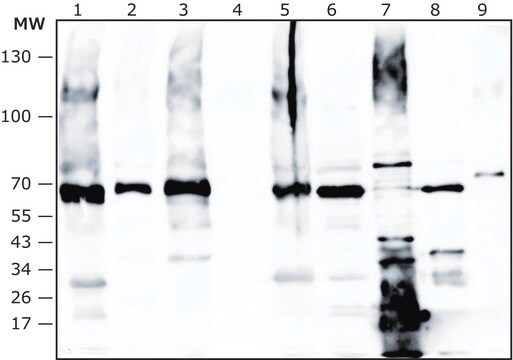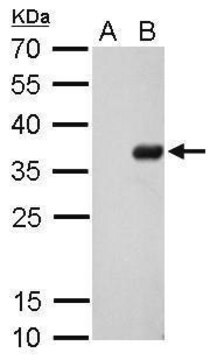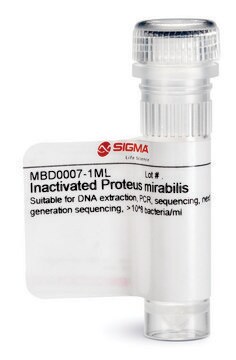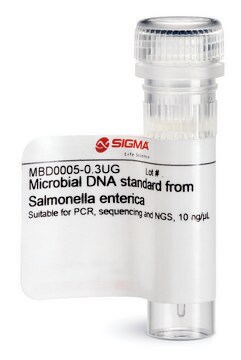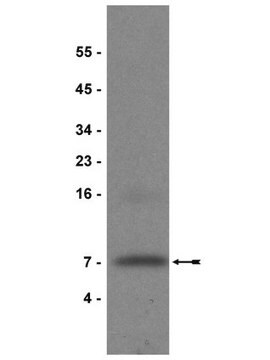추천 제품
생물학적 소스
rabbit
항체 형태
IgG fraction of antiserum
클론
polyclonal
설명
Research area: Microbiome
양식
buffered aqueous solution
분자량
~70 kDa
종 반응성
Proteus mirabilis
포장
antibody small pack of 25 μL
농도
~1 mg/mL
기술
immunoblotting: 1:10,000-1:20,000 using Proteus mirabilis LPS
indirect ELISA: 1:16,000-1:32,000
배송 상태
dry ice
저장 온도
−20°C
타겟 번역 후 변형
unmodified
관련 카테고리
일반 설명
Proteus mirabilis is a Gram negative rod-shaped bacteria, belongs to the Enterobacteriaceae family. Member of the Proteus genus (Proteus spp.) which also includes Proteus mirabilis, Proteus penneri and Proteus hauseri, originally characterize by their ability to swarm on solid surfaces, are widespread in the environment and the gastrointestinal tract of human and animals and known to be an opportunistic pathogens isolated from urine, wounds and other clinical sources. The Proteus spp. bacteria, are distinguished by their reactions for indole production, salicin fermentation and aesculin hydrolysis. P. vulgaris produces indole which differentiates it from the indole-negative P. mirabilis and P. penneri. Proteus spp. bacteria may also be found in soil or water habitats where they often regarded as indicators of fecal pollution and a contamination threat for potential water or seafood poisoning.
면역원
Proteus mirabilis OXK dead bacteria, ATCC strain 15146
애플리케이션
Anti-Proteus mirabilis antibody recognizes P. mirabilis whole extract and P. mirabilis LPS, the antibody also recognizes an additional ~70kDa band suspected as bacterial HSP70 (DNAK) in whole extract P. vulgaris, P. gingivalis, E.coli K-12, P.aeruginosa, S. flexneri, S. enterica and E. faecalis but it has no cross reactivity with P. vulgaris LPS. The antibody may be used in various immunochemical techniques including Immunoblotting and ELISA.
물리적 형태
Supplied as a solution in 0.01 M phosphate buffered saline pH 7.4, containing 15 mM sodium azide as a preservative.
기타 정보
This product is for R&D use only, not for drug, household, or other uses.
면책조항
This product is for R&D use only, not for drug, household, or other uses.
Storage Class Code
10 - Combustible liquids
WGK
WGK 1
Flash Point (°F)
Not applicable
Flash Point (°C)
Not applicable
가장 최신 버전 중 하나를 선택하세요:
Jessica N Schaffer et al.
Microbiology spectrum, 3(5) (2015-11-07)
Proteus mirabilis is a Gram-negative bacterium and is well known for its ability to robustly swarm across surfaces in a striking bulls'-eye pattern. Clinically, this organism is most frequently a pathogen of the urinary tract, particularly in patients undergoing long-term
Noriyuki Nagano et al.
Journal of clinical microbiology, 41(12), 5530-5536 (2003-12-10)
Nineteen multidrug-resistant Proteus mirabilis strains were isolated from 19 patients suffering from infections probably caused by P. mirabilis. These strains were recovered from urine or other urogenital specimens of 16 inpatients and three outpatients with a hospitalization history in a
ANTIMICROBIAL RESISTANCE PATTERNS OF PROTEUS ISOLATES FROM CLINICAL SPECIMENS
Bahashwan, et al.
EUROPEAN SCIENTIFIC JOURNAL, 9, 188-202 (2013)
C M O'Hara et al.
International journal of systematic and evolutionary microbiology, 50 Pt 5, 1869-1875 (2000-10-18)
Strains traditionally identified as Proteus vulgaris formed three biogroups. Biogroup 1, characterized by negative reactions for indole production, salicin fermentation and aesculin hydrolysis, is now known as Proteus penneri. Biogroup 2, characterized by positive reactions for indole, salicin and aesculin
N Pal et al.
Annals of medical and health sciences research, 6(5), 267-273 (2017-05-16)
Proteus species cause a variety of community- and hospital-acquired illnesses. Synthesis of β-lactamases is the predominant mechanism for resistance to β-lactam antibiotics. Among the β-lactamases, extended spectrum β-lactamases (ESBLs) and AmpC β-lactamases are the most common. The objective of this
자사의 과학자팀은 생명 과학, 재료 과학, 화학 합성, 크로마토그래피, 분석 및 기타 많은 영역을 포함한 모든 과학 분야에 경험이 있습니다..
고객지원팀으로 연락바랍니다.